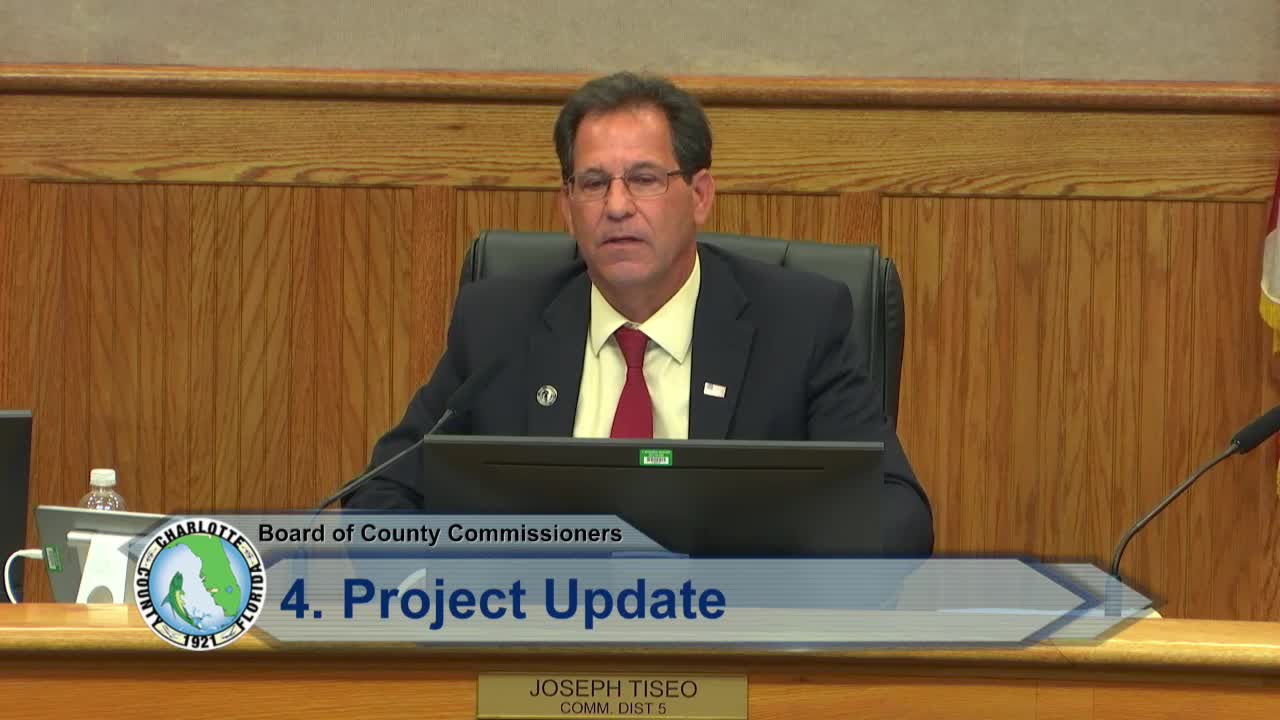County selects ‘forward-looking’ interim expansion for Burnt Store WRF and approves temporary treatment unit purchase
October 14, 2025 | Charlotte County, Florida
This article was created by AI summarizing key points discussed. AI makes mistakes, so for full details and context, please refer to the video of the full meeting. Please report any errors so we can fix them. Report an error »

Charlotte County commissioners Oct. 14 approved a county recommendation to pursue a Burnt Store Water Reclamation Facility interim alternative that is designed to be compatible with the county’s longer-term 2.5 million gallons per day expansion.
What was decided: After review of four interim alternatives, the board chose the option the consultant described as “forward‑looking.” That option calls for building new headworks, a new equalization tank sized and located for future expansion, and constructing a 1.25‑MGD advanced-treatment train that could serve as the first half of a future 2.5‑MGD plant. Consultants presented high-level order‑of‑magnitude costs for the alternatives and explained how much of each interim plan’s capital investment would be reusable for the future full expansion; the board selected the alternative with the highest reusability and advanced-treatment capability.
Temporary treatment units (amendment 1): Separately, the board approved Amendment 1, a guaranteed‑maximum-price style action to purchase and connect temporary packaged treatment units and required infrastructure to provide near‑term additional capacity while permanent expansion design and construction proceed. Commissioners approved the amendment authorizing procurement and infrastructure work (the staff materials reflect an overall GMP-level amount in the $7.9 million range for the modular units and associated connection work), and the board directed staff to finalize the amendment language to reflect a supplier credit that appears in the backup documentation.
Why the board chose this path: Consultants said Burnt Store’s existing build-out will reach roughly 1.0 MGD average day flow by about 2036 under current growth assumptions. The recommended alternative advances the county’s ability to meet advanced‑treatment requirements and positions new construction in locations and configurations that can be carried forward into the county’s planned larger expansion — reducing future duplication of capital spend. The interim unit purchase gives the utility breathing room to meet near-term demand while the larger expansion proceeds.
Quotes and record: The consultant said the recommended alternative “is the most cost-effective over the long term” because “virtually everything in option 4 is reusable” for the future 2.5‑MGD facility. Commissioners voted unanimously to approve the recommendation and then unanimously approved Amendment 1 to contract language authorizing the temporary units, with the board instructing staff to include a $400,000 supplier credit in the final signature documents.
Next steps: Staff will proceed with procurement and site connection work for the temporary units and continue design and financing planning for the longer-term 2.5‑MGD expansion. Commissioners asked that quarterly updates track when the temporary units need to be brought on and whether additional modular capacity must be purchased.
Ending: By approving the forward-looking interim option and a GMP‑style amendment for temporary units, the board balanced near-term capacity relief and longer-term capital stewardship.
What was decided: After review of four interim alternatives, the board chose the option the consultant described as “forward‑looking.” That option calls for building new headworks, a new equalization tank sized and located for future expansion, and constructing a 1.25‑MGD advanced-treatment train that could serve as the first half of a future 2.5‑MGD plant. Consultants presented high-level order‑of‑magnitude costs for the alternatives and explained how much of each interim plan’s capital investment would be reusable for the future full expansion; the board selected the alternative with the highest reusability and advanced-treatment capability.
Temporary treatment units (amendment 1): Separately, the board approved Amendment 1, a guaranteed‑maximum-price style action to purchase and connect temporary packaged treatment units and required infrastructure to provide near‑term additional capacity while permanent expansion design and construction proceed. Commissioners approved the amendment authorizing procurement and infrastructure work (the staff materials reflect an overall GMP-level amount in the $7.9 million range for the modular units and associated connection work), and the board directed staff to finalize the amendment language to reflect a supplier credit that appears in the backup documentation.
Why the board chose this path: Consultants said Burnt Store’s existing build-out will reach roughly 1.0 MGD average day flow by about 2036 under current growth assumptions. The recommended alternative advances the county’s ability to meet advanced‑treatment requirements and positions new construction in locations and configurations that can be carried forward into the county’s planned larger expansion — reducing future duplication of capital spend. The interim unit purchase gives the utility breathing room to meet near-term demand while the larger expansion proceeds.
Quotes and record: The consultant said the recommended alternative “is the most cost-effective over the long term” because “virtually everything in option 4 is reusable” for the future 2.5‑MGD facility. Commissioners voted unanimously to approve the recommendation and then unanimously approved Amendment 1 to contract language authorizing the temporary units, with the board instructing staff to include a $400,000 supplier credit in the final signature documents.
Next steps: Staff will proceed with procurement and site connection work for the temporary units and continue design and financing planning for the longer-term 2.5‑MGD expansion. Commissioners asked that quarterly updates track when the temporary units need to be brought on and whether additional modular capacity must be purchased.
Ending: By approving the forward-looking interim option and a GMP‑style amendment for temporary units, the board balanced near-term capacity relief and longer-term capital stewardship.
View full meeting
This article is based on a recent meeting—watch the full video and explore the complete transcript for deeper insights into the discussion.
View full meeting